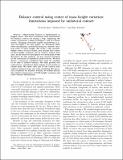| dc.contributor.author | Koolen, Twan | |
| dc.contributor.author | Posa, Michael | |
| dc.contributor.author | Tedrake, Russell L | |
| dc.date.accessioned | 2019-09-16T19:16:16Z | |
| dc.date.available | 2019-09-16T19:16:16Z | |
| dc.date.issued | 2016-11 | |
| dc.identifier.isbn | 9781509047185 | |
| dc.identifier.uri | https://hdl.handle.net/1721.1/122102 | |
| dc.description.abstract | Maintaining balance is fundamental to legged robots. The most commonly used mechanisms for balance control are taking a step, regulating the center of pressure ('ankle strategies'), and to a lesser extent, changing centroidal angular momentum (e.g., 'hip strategies'). In this paper, we disregard these three mechanisms, instead focusing on a fourth: varying center of mass height. We study a 2D variable-height center of mass model, and analyze how center of mass height variation can be used to achieve balance, in the sense of convergence to a fixed point of the dynamics. In this analysis, we pay special attention to the constraint of unilateral contact forces. We first derive a necessary condition that must be satisfied to be able to achieve balance. We then present two control laws, and derive their regions of attraction in closed form. We show that one of the control laws achieves balance from any state satisfying the necessary condition for balance. Finally, we briefly discuss the relative importance of CoM height variation and other balance mechanisms. 2016 IEEE. | en_US |
| dc.language.iso | en | |
| dc.publisher | IEEE | en_US |
| dc.relation.isversionof | 10.1109/humanoids.2016.7803247 | en_US |
| dc.rights | Creative Commons Attribution-Noncommercial-Share Alike | en_US |
| dc.rights.uri | http://creativecommons.org/licenses/by-nc-sa/4.0/ | en_US |
| dc.source | MIT web domain | en_US |
| dc.title | Balance control using center of mass height variation: Limitations imposed by unilateral contact | en_US |
| dc.type | Article | en_US |
| dc.identifier.citation | Koolen, Twan, et al. Balance Control Using Center of Mass Height Variation: Limitations Imposed by Unilateral Contact. IEEE, 2016, pp. 8–15. CrossRef, doi:10.1109/HUMANOIDS.2016.7803247. | en_US |
| dc.contributor.department | Massachusetts Institute of Technology. Department of Electrical Engineering and Computer Science | en_US |
| dc.eprint.version | Author's final manuscript | en_US |
| dc.type.uri | http://purl.org/eprint/type/ConferencePaper | en_US |
| eprint.status | http://purl.org/eprint/status/NonPeerReviewed | en_US |
| dc.date.updated | 2019-07-11T12:48:54Z | |
| dspace.date.submission | 2019-07-11T12:48:55Z | |
